2019 Rd.4 RALLY FRANCE
WRC 2019 ROUND 4 RALLY FRANCE

SUMMARY REPORT
The Tour de Corse is the fourth round of the FIA World Rally Championship, and the first full-tarmac rally of the season. The TOYOTA GAZOO Racing World Rally Team was fully prepared as it arrived for the start of the rally: the team’s goal was, of course, victory. In order to achieve this goal, it was vital that the team avoided problems with its cars. While the team had experienced an alternator issue at the previous Rally Mexico, it had started investigating solutions the day after the rally finished and, together with its parts supplier, made improvements. As a result, the alternator worked trouble-free at the Tour de Corse, and the data inspections that the team carried out after the event also showed numbers that were in the expected range.
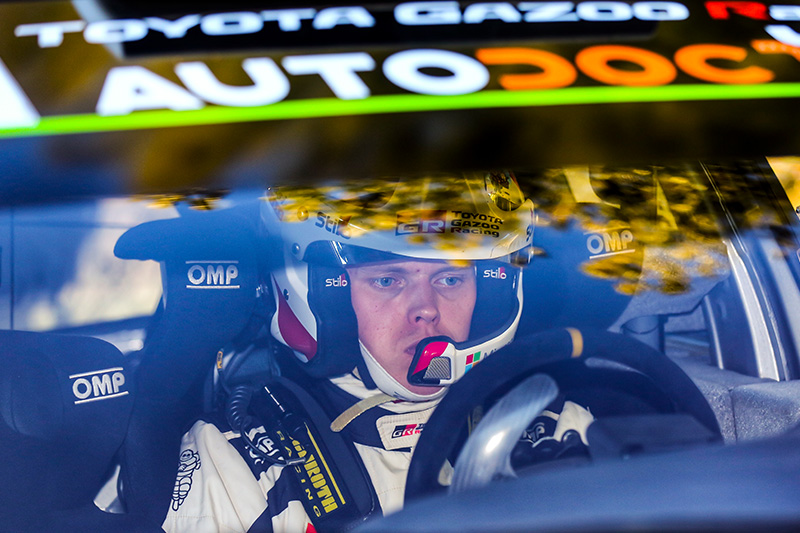
Indeed, for the team, this demonstrates a significant difference to last year: even when a problem occurs, it is able to identify the cause with far greater speed. The fact that the team’s relationship with Toyota Motor Corporation has been further strengthened, and that development know-how and improvement methods are being fully shared, is extremely important. The sense of speed when developing racing cars and the pursuit of marginal gains on the one hand, and the rigorous quality controls when developing production vehicles and the accumulation of wide-ranging data on the other—TOYOTA GAZOO Racing World Rally Team and Toyota Motor Corporation are fusing the technologies and methodologies they have cultivated in their respective fields of expertise, and are becoming a works team in the true meaning of the phrase.

The team lined up at the Tour de Corse fully prepared. However, in terms of results it turned out to be the most disappointing rally of the season. Ott Tänak was the highest-placed driver in sixth overall, with Kris Meeke finishing ninth and Jari-Matti Latvala tenth. This was the first time this season that the team had not stood on the podium. Tänak fell from the first to third in the drivers’ championship, with TOYOTA GAZOO Racing World Rally Team likewise dropping from first to third in the manufacturers’ championship.
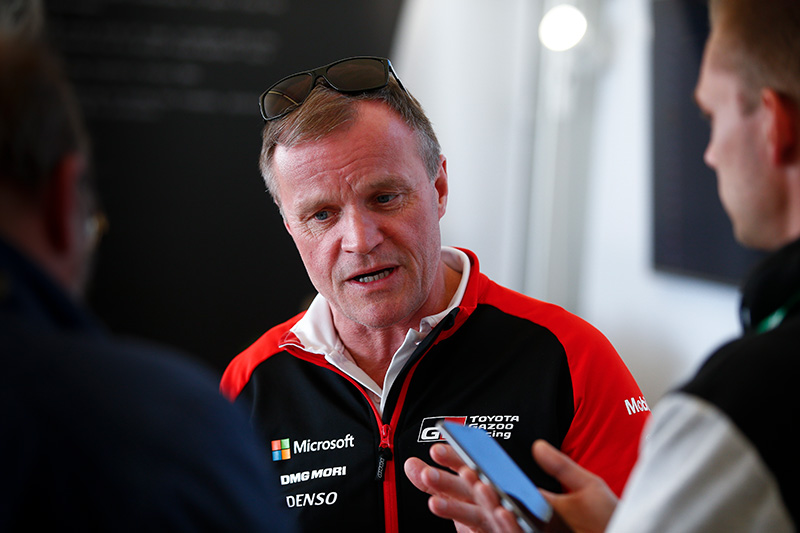
But, it was not a case of the Yaris WRC being too slow. On the contrary, the car was fastest in six of the 14 Special Stages, and second fastest in a further eight. In the Power Stage, where bonus championship points are on offer, Meeke was first and Tänak second. This indicates that the Yaris WRC was not inferior to its rivals in terms of pure speed. Indeed, the drivers were satisfied with the condition of the Yaris WRC, noting: “The car is extremely easy to control and fun to drive.”

Nevertheless, the team was unable to place a single driver in the top five, and the chief reason for this was lost time due to air-loss from the cars’ tires. There were a variety of causes for the air-loss: tires were punctured from running over sharp stones, for example, while wheels were damaged when overcoming height differences in the road surface or when hitting curbs. At the Tour de Corse, all three Yaris WRCs were affected by air-loss, and this made it impossible to achieve a high-placed finish.

Corsica’s tarmac stages are a mix of old and new paved roads. The surfaces of the older roads are in extremely poor condition, with numerous cracks and holes. The road shoulder is also unpaved in many areas, and graveled over instead. The gravel shoulders are somewhat lower than the paved surfaces of the roads themselves, and so drivers often drop the tires on one side of their cars into the gravel. In particular, the method of cutting the apex of a corner is a typical rally technique—it massively increases the freedom drivers have to choose a cornering line, and contributes to faster times.
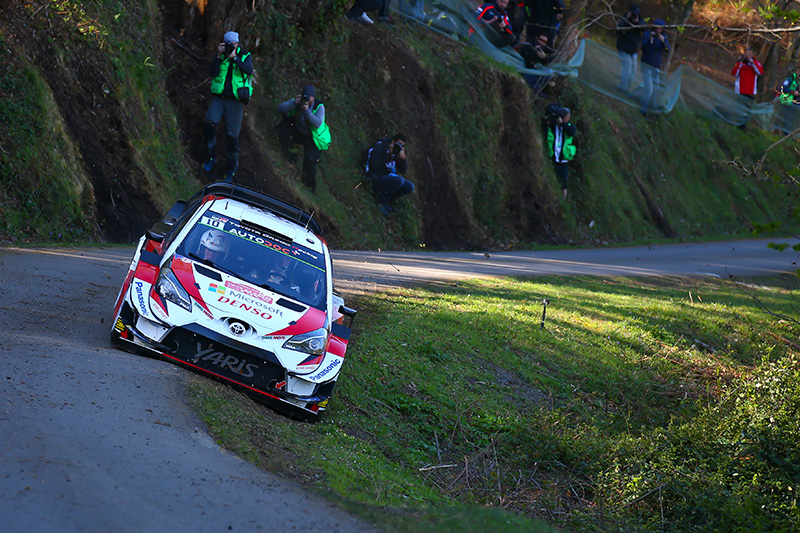
And yet, sharp stones can also be present in the gravel shoulders. Drivers therefore examine the shoulders with great care during their recces (an abbreviation of “reconnaissance,” where drivers check out the courses before the start of the rally), and write their findings down in their pacenotes. If a driver feels that a corner contains numerous large or sharp stones, he will write “don’t cut”; this will be read out during the rally by the co-driver, so alerting the driver to the danger. In order to determine accurately whether a corner can be cut, some drivers even leave their cars during the recce and examine the condition of the shoulders at first-hand.
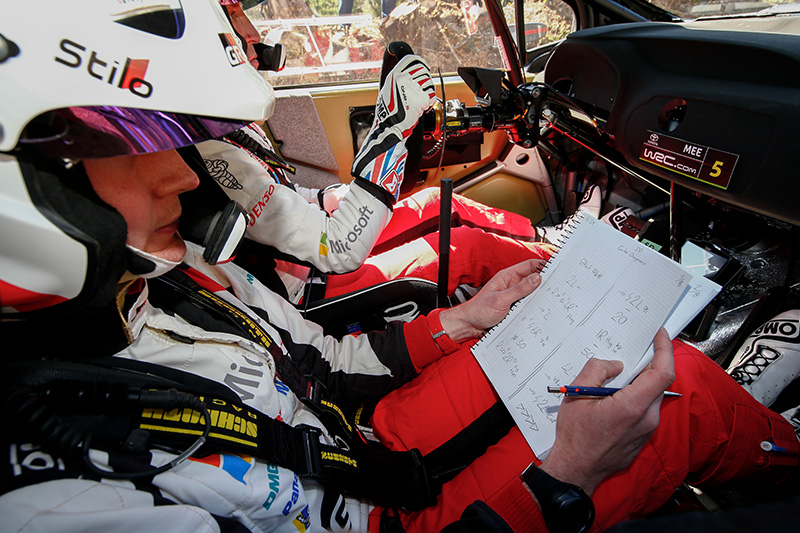
But no matter how carefully shoulders are checked, cutting an apex has an element of risk; this is because preceding cars might have dug up sharp stones from among the gravel. In addition, the height difference between the road and the shoulder jolts the car and makes wheel and suspension damage more likely. In other words, if a driver wants to eliminate risk, he should not cut the apex or use the full width of the road. And, in fact, when drivers have a speed advantage, they will select driving lines that prioritize safety. In spite of this, when drivers are competing with rivals over tenths of a second, they have to accept the risks of cutting apexes and use the very outside of the road when exiting the corners.
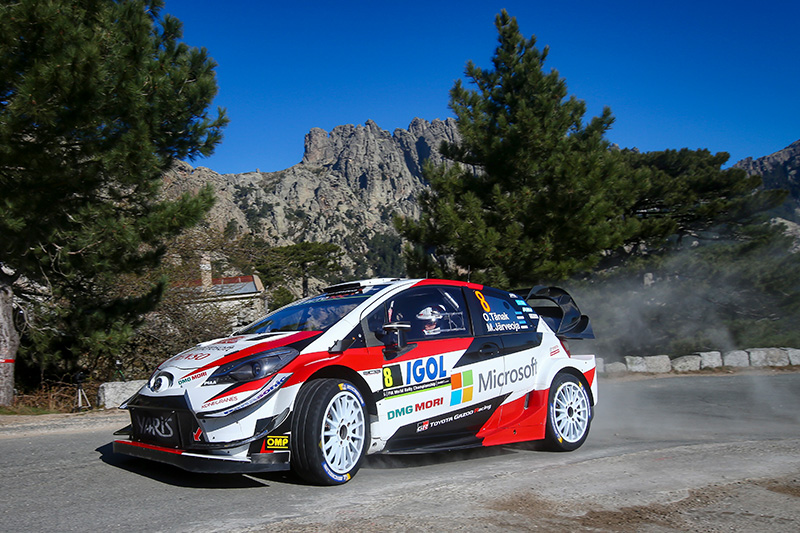
At the Tour de Corse, while the three team drivers did not all suffer air-loss through corner-cutting—the reason behind one instance of air-loss has not been fully understood. And yet, if the drivers had gained a bigger advantage over their rivals, then perhaps they would not have been forced to drive aggressively and take such risks.
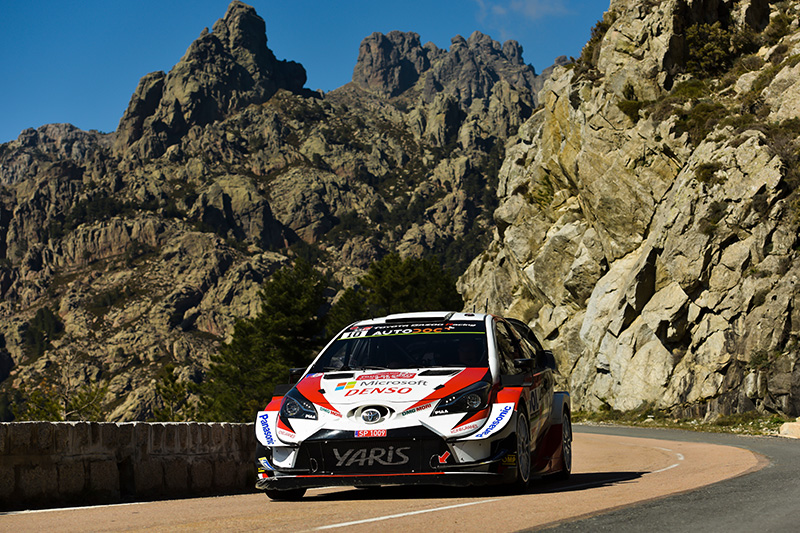
From the start of the rally, Tänak was engaged in a fierce battle for the lead with Elfyn Evans. Despite fighting over tenths of a second across numerous stages, Tänak remained calm and drove extremely cleanly. Team Principal Tommi Mäkinen instructed his driver to “drive as much as possible in the middle of the road,” and the Estonian obeyed. Nevertheless, on SS11, which had one of the better road surfaces of Day Two’s stages, Tänak damaged his wheel rim. He lost approximately two minutes changing his wheel. As a result, he dropped down the standings from the lead, and let the chance of a podium finish slip through his fingers.
Meeke, meanwhile, ran over a stone on the inside of a corner on SS1 of the rally. The shock damaged his wheel rim and deflated his tire, causing him to lose a significant amount of time. Meeke recorded the first of three fastest times at the Tour de Corse on SS2, demonstrating he would have had the speed to compete for victory. But he was then significantly affected by suspension damage, losing more time on Special Stages 5 and 6. Considering how fast he was, Meeke’s overall finishing position of ninth was a disappointing result.

Evans, who had inherited the rally lead from Tänak, was subsequently involved in a fierce battle for victory with Thierry Neuville until the very end of the Tour de Corse; nevertheless, he was denied an almost certain win by a puncture on the last stage of the rally. It turns out that all the drivers competing for the win were driving to the utmost limits. Having lost his front-right tire, a despairing Evans finished the final SS with a bare wheel—and Tänak was the first driver to go over and console him. Meeke and his co-driver Seb Marshall also put their hands on Evans’ shoulder in a show of sympathy and praised his performance. It was a scene that demonstrated the pure sporting essence of rallying.
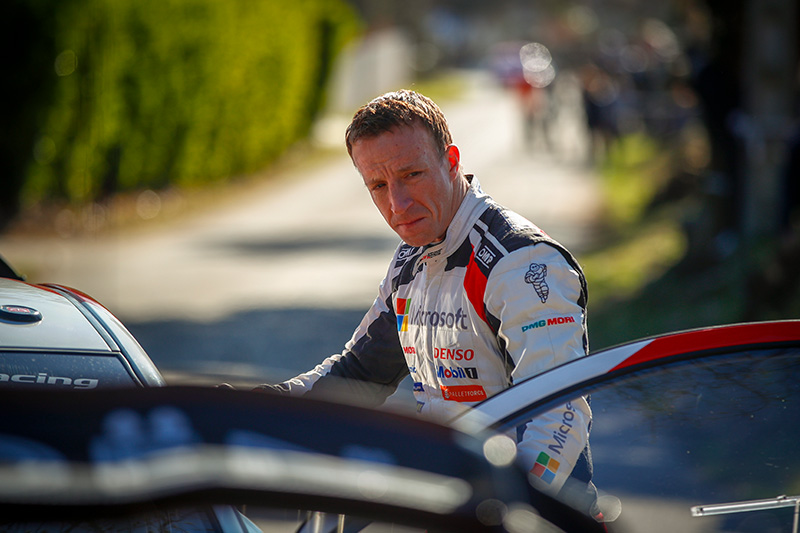
Suffering a puncture after rolling over a sharp stone is, at least in part, down to bad luck. On the other hand, suffering rim damage due to an impact from the road surface is something that can be prevented. The team had experienced rim damage at the season opener in Monte Carlo as well; it therefore arrived at the Tour de Corse with wheels that had high impact resistance but, in the end, this was not enough to completely prevent rim damage. Even though the team has implemented measures to prevent wheel damage on tarmac stages, the frequency of damage is slightly higher than last year. There are numerous possible factors; although two likely causes are the fact that this year’s Yaris WRC is faster than last year’s, and the fact that the competition against the team’s rivals is fiercer, forcing drivers to take more risks. After suffering rim damage again, the team took the wheels to Toyota Motorsport GmbH in Germany, where its analysis tools are located, and began investigations.
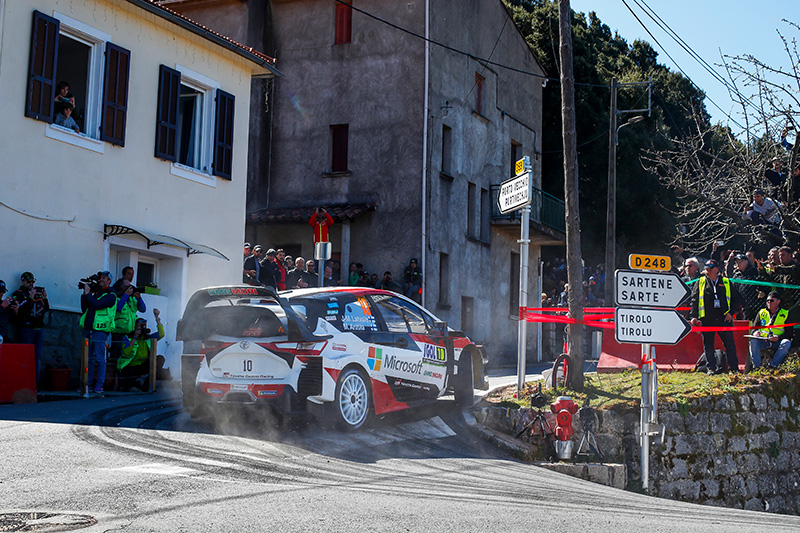
The TOYOTA GAZOO Racing World Rally Team could easily ask its supplier to build more durable wheels—increasing the thickness of the wheels, for example, would make them tougher. But this would also result in an increase in the weight of the wheels, and it goes without saying that increased weight would lead to a drop in the car’s performance. In particular, the wheels are part of the car’s suspension system, and any increase in weight under the springs has a significant impact on the car’s driving performance.
The key is finding the right balance between light weight and robustness; however, it may well be that the team’s setup in this regard was not optimal. In addition, light weight and robustness is not solely a matter of wheel design—it relates to the entire car. The team may have prioritized light weight over strength when designing the car, and this means that going forward every component must be examined carefully. The faster the Yaris WRC becomes, the greater the stress placed on each component. Thus, the world of motorsports demands that car development anticipates this increased stress. There is no end to developing a car that is both fast and strong.
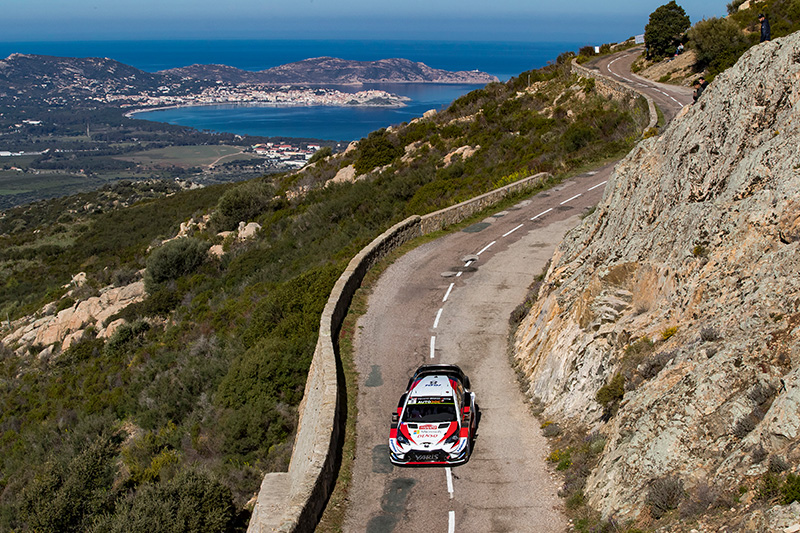
| Pos | Driver | Co-Driver | Vehicle | Time | |
|---|---|---|---|---|---|
| 1 | Thierry Neuville | Nicolas Gilsoul | Hyundai i20 Coupe WRC | 3h22m59.0s | |
| 2 | Sebastien Ogier | Julien Ingrassia | Citroën C3 WRC | +40.3s | |
| 3 | Elfyn Evans | Scott Martin | Ford Fiesta WRC | +1m06.6s | |
| 4 | Dani Sordo | Carlos del Barrio | Hyundai i20 Coupe WRC | +1m18.4s | |
| 5 | Teemu Suninen | Marko Salminen | Ford Fiesta WRC | +1m24.6s | |
| 6 | Ott Tänak | Martin Järveoja | Toyota Yaris WRC | +1m40.0s | |
| 7 | Esapekka Lappi | Janne Ferm | Citroën C3 WRC | +2m09.1s | |
| 8 | Sebastien Loeb | Daniel Elena | Hyundai i20 Coupe WRC | +3m39.2s | |
| 9 | Kris Meeke | Seb Marshall | Toyota Yaris WRC | +5m06.3s | |
| 10 | Jari-Matti Latvala | Miikka Anttila | Toyota Yaris WRC | +6m44.6s |
- RELATED TOPICS
-
-
TOYOTA GAZOO Racing World Rally Team
launches 2019 challenge at the Autosport International showThe 2019 FIA World Rally Championship season has been launched today in front of thousands of motorsport fans at the Autosport International show in Birmingham, England. TOYOTA GAZOO Racing World Rally Team is in attendance with its manufacturers’ championship-winning Yaris WRC car and its full squad of drivers and co-drivers. -
WRC 2019 ROUND 4 TOUR DE CORSE Gallery
-